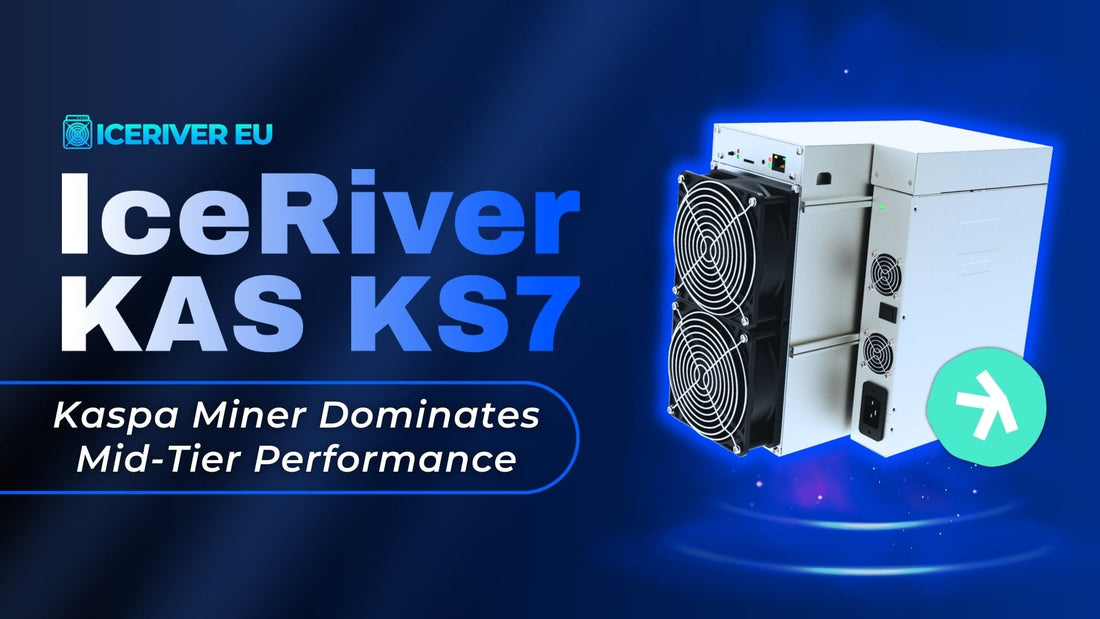Introduction: The Rise of Kaspa Mining in 2025
Kaspa (KAS) has quickly become one of the most exciting coins to mine, thanks to its blockDAG architecture, fast confirmation times, and growing adoption in the crypto space. For miners, it represents an opportunity to profit from an innovative network that’s still in its growth phase.
But Kaspa mining isn’t just about plugging in any ASIC — it’s about finding the right balance of hashrate, efficiency, energy cost, and ROI. And this is where IceRiver’s KS7 ASIC miner stands out.
The IceRiver KS7 is designed for mid-tier mining performance, meaning it sits between entry-level rigs like the KS1 and flagship powerhouses like the KS3M. This makes it appealing for miners who want strong profitability without the high energy draw, excessive noise, and heavy upfront cost of flagship units.
In this review, we’ll break down why the KS7 dominates the mid-tier category, covering everything from technical specs and profitability to hosting strategies, comparisons, and long-term potential.
⚡ Understanding the IceRiver KS7
At its core, the KS7 is all about efficiency and balance.

What does this mean? It means the KS7 is optimized to generate maximum hashrate while consuming less electricity compared to other miners in its category. For Kaspa miners, where margins depend heavily on energy cost, this efficiency is critical.
Why Efficiency Matters in Kaspa Mining
Unlike Bitcoin, where block rewards are more established, Kaspa’s profitability is still highly sensitive to market trends. The more efficient your miner, the better your ability to ride out price volatility while staying profitable.
-
A miner at 600 W/TH (like the KS1) struggles to remain profitable at higher energy costs.
-
The KS7 at 152 W/TH stays competitive even when KAS dips, making it more future-proof.
💸 Profitability Analysis of the KS7
Let’s look at profitability in real numbers.
Daily Energy Consumption:
3,040W × 24h = 72.96 kWh/day
Hosting Costs at IceRiver EU Centers:
-
🇳🇬 Nigeria ($0.0525/kWh) = $3.83/day electricity
-
🇦🇪 Dubai ($0.0575/kWh) = $4.19/day electricity
-
🇺🇸 South Carolina, USA ($0.065/kWh) = $4.74/day electricity
Gross Revenue (current averages):
~$16–$19/day depending on KAS price and network difficulty
Net Profit (Dubai Example):
$16–$19 – $4.19 = $12–$15/day
ROI Timeline:
At ~$3,000–$3,500 hardware cost → 6.5–8 months break-even
👉 With IceRiver’s AI Smart Mining optimization and 99.9% uptime guarantees, miners can shorten that ROI window even further.

🏭 Who Is the KS7 Best For?
The KS7 isn’t designed to compete with the absolute top-tier machines like the KS3M — instead, it’s built for practical miners who want profitability without overextension.
Ideal users include:
-
Mid-size farm operators scaling profitably without extreme energy draw.
-
Miners using hosting services who want maximum ROI per rack unit.
-
Crypto investors diversifying portfolios into mining for passive income.
-
Home miners who want something powerful but not overwhelmingly loud/expensive.
With compact design, lower energy requirements, and strong efficiency, the KS7 is versatile enough for both hosted facilities and smaller private setups.
📊 Comparison: KS7 vs Other Kaspa Miners
Here’s how the KS7 stacks up against other popular Kaspa ASICs:

✅ Verdict: The KS7 leads mid-tier miners in efficiency and ROI speed. While the KS3M has more power, it requires higher energy draw and upfront investment, making the KS7 more attractive for ROI-focused miners.
🌍 Hosting With IceRiver EU
Mining at home comes with challenges: noise, heat, power limitations. That’s why many miners choose professional hosting facilities.

Available Hosting Regions:
- 🇳🇬 Nigeria – $0.0525/kWh
- 🇪🇹 Ethiopia – $0.0549/kWh
- 🇦🇪 Dubai – $0.0575/kWh
- 🇺🇸 South Carolina, USA – $0.065/kWh
- 🇫🇮 Finland – $0.065/kWh
- 🇳🇴 Norway – $0.078/kWh
Hosting transforms the KS7 into a plug-and-play profit generator — miners only need to track ROI via the IceRiverEU dashboard.
How to Maximize KS7 ROI
- Choose the right hosting location – Even small differences in kWh cost impact profitability. Nigeria vs Norway can shift ROI by 2–3 months.
- Monitor uptime regularly – A 1% drop in uptime = noticeable revenue loss. Always track dashboards.
- Upgrade strategically – If your KS7 consistently delivers above-average efficiency, reinvesting in more units can compound profits.
- Plan for volatility – Kaspa price swings can affect ROI. Efficient miners like the KS7 are safer in downturns.
-
Diversify hosting – Some miners split units across multiple IceRiver sites to balance risks like power outages or regional price shifts.
🏆 Final Thoughts
The IceRiver KS7 represents the perfect balance for Kaspa mining in 2025:
- ⚡ Efficient 152 W/TH performance
- 💸 6.5–8 month ROI
- 🌍 Global hosting from $0.0525/kWh
-
📊 AI optimization & 99.9% uptime
If you’re a miner looking for sustainable profitability without the headaches of oversized rigs, the KS7 is your sweet spot.
👉 Pre-order your KS7 today or explore IceRiver Hosting to find the best location for your mining setup.
➡️ Ready to secure your profitability in 2025?
Visit iceriver.eu or hosting.iceriver.eu today 🚀

